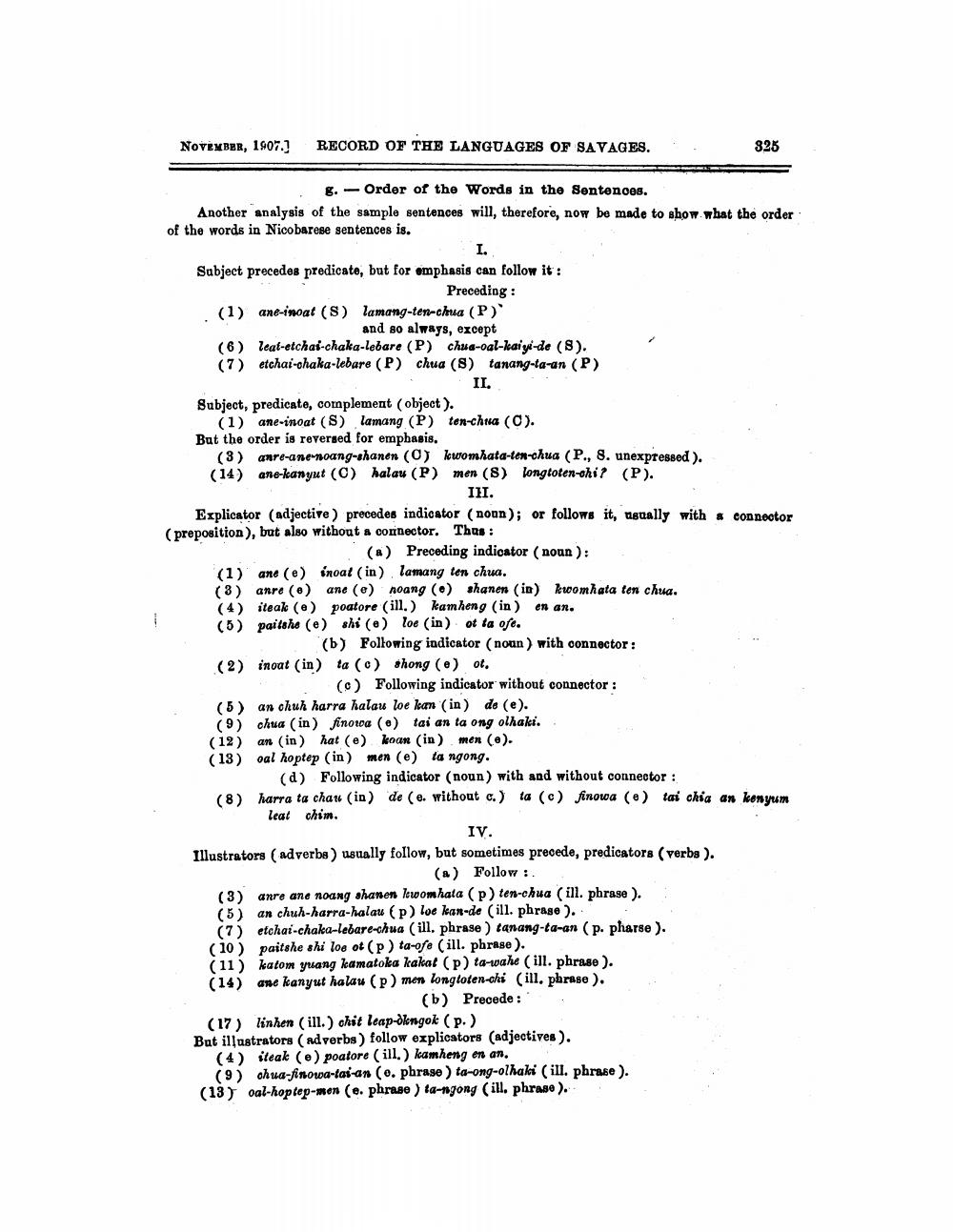________________
NOVEMBER, 1907.]
RECORD OF THE LANGUAGES OF SAVAGES.
8.
Order of the Words in the Sentences.
Another analysis of the sample sentences will, therefore, now be made to show what the order of the words in Nicobarese sentences is.
I.
Subject precedes predicate, but for emphasis can follow it:
Preceding: (1) ane-inoat (S) lamang-ten-chua (P)` and so always, except
(6) leat-etchai-chaka-lebare (P) chua-oal-kaiyi-de (8). (7) etchai-chaka-lebare (P) chua (8) tanang-ta-an (P) II.
Subject, predicate, complement (object).
(1) ane-inoat (S) lamang (P) ten-chua (C).
But the order is reversed for emphasis.
(3) anre-ane-noang-shanen (C) kwomhata-ten-chua (P., 8. unexpressed). (14) ane-kanyut (C) halau (P) men (8) longtoten-chi? (P).
III.
Explicator (adjective) precedes indicator (noun); or follows it, usually with a connector (preposition), but also without a connector. Thus:
(a) Preceding indicator (noun): lamang ten chua.
ane (e) noang (e) shanen (in) kwomhata ten chua. poatore (ill.) kamheng (in) en an. shi (e) loe (in) ot ta ofe.
(1) ane (e) inoat (in) (3) anre (e) (4) iteak (e) (5) pailshe (e)
(b) Following indicator (noun) with connector: (2) inoat (in) ta (c) shong (e) ot.
(c) Following indicator without connector:
(5) an chuh harra halau loe han (in) de (e). (9) chua (in) finowa (e) tai an ta ong olhaki. (12) an (in) hat (e) koan (in) men (e). (13) oal hoptep (in) men (e) ta ngong.
(d) Following indicator (noun) with and without connector:
325
(8) harra ta chau (in) de (e. without c.) ta (c) finowa (e) tai chia an kenyum leat chim.
IV.
Illustrators (adverbs) usually follow, but sometimes precede, predicators (verbs). (a) Follow:
(3) anre ane noang shanen kwomhata (p) ten-chua (ill. phrase). (5) an chuh-harra-halau (p) loe kan-de (ill. phrase).
(7) etchai-chaka-lebare-chua (ill. phrase) tanang-ta-an (p. pharse). (10) paitshe shi loe ot (p) ta-ofe (ill. phrase). (11) katom yuang kamatoka kakat (p) ta-wahe (ill. phrase). (14) ane kanyut halau (p) men longtoten-chi (ill. phrase). (b) Precede: (17) linhen (ill.) ohit leap-okngok (p.)
But illustrators (adverbs) follow explicators (adjectives). (4) steak (e) poatore (ill.) kamheng en an.
(9) chua-finowa-tai-an (e. phrase) ta-ong-olhaki (ill. phrase). (13) oal-hoptep-men (e. phrase) ta-ngong (ill. phrase).




